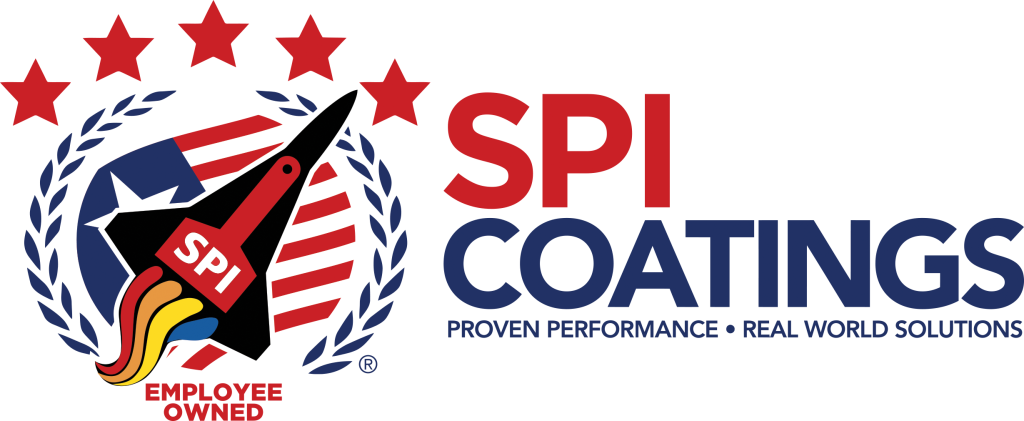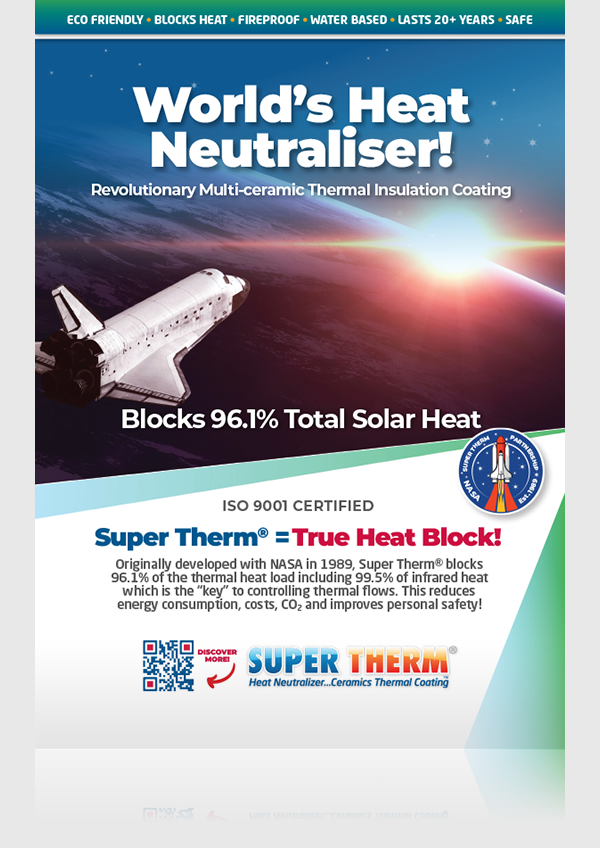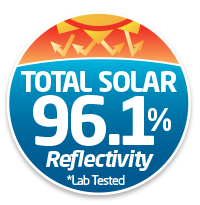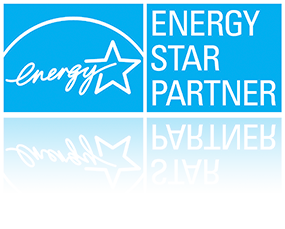Eco Friendly Cool Roof
Super Therm® is great for our environment and your pocket
Super Therm® as an Energy Star rated and environmentally-safe coating that addresses both genuine heat block and fire protection with minimal application effort. The uses for Super Therm® are numerous and only limited by one’s imagination where you want to save money on electricity costs, invest into something long term and have it good for the environment.
It’s safe, water-based, sustainable and effective. Super Therm® is a high tech solar heat block coating (not reflective), NASA tested with an A & K fire and smoke rating and is warranted for 20 years*. It has low and safe VOC ratings, provides durability and longevity as shown in 30 year test results; ultimately is creates a highly valuable reduction of your cooling energy demand due to solar reflectivity and emissivity. It works by blocking most of the total solar heat…the best multi-ceramic solar heat block coating solution worldwide!
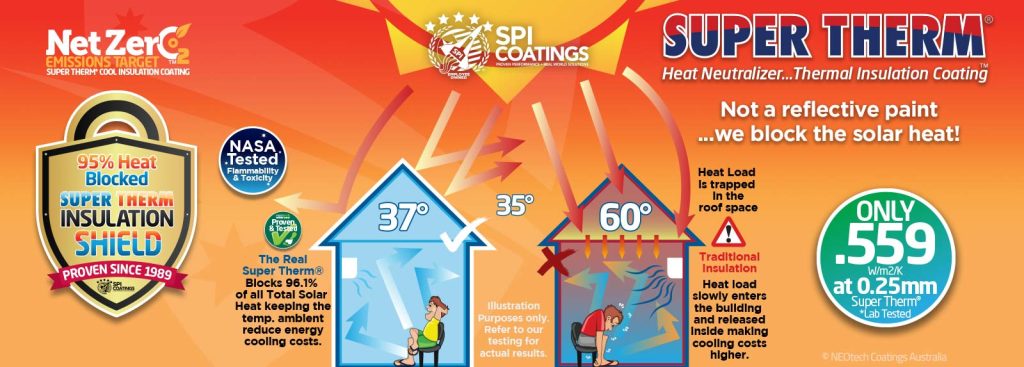
Key Super Therm® Benefits:
- 367 to 4 BTU heat blocked
- VOC rating 67 grams/litre – Low
- Virtually No Heat Load
- Non toxic and no offgassing
- Water based and water soluble
- Reduced demands on KW and power by 40%
- 20 year lifespan (slight reduction of efficiency over time)
Key Super Therm® Safety benefits:
- Safe for rainwater catchment
- Can be used around food preparation facilities
- Prevents mould and mildew
- No fire spread
- EPA (US) endorsed
- Outstanding savings for business and residential
- Helps companies reach ISO 14000 standards
KW savings = Actual Dollar Savings
Did you know a 6° reduction in the thermostat produces energy consumption reductions. Con Edison
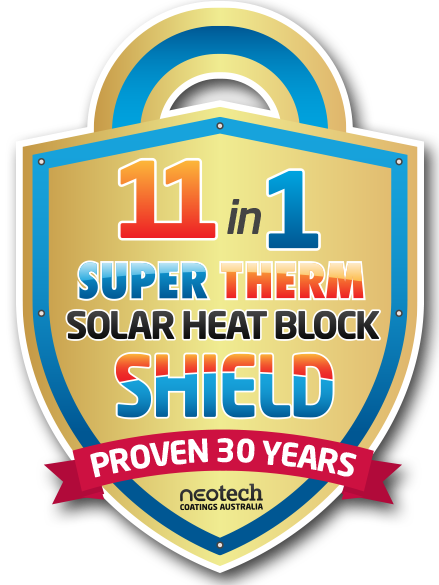
Super Therm® has proven itself by the thousands of successful worldwide applications since 1989. In today’s environmentally focused climate Super Therm® ceramic coating has proven to be the only truly sustainable and successful solution extensively tested!
- See Super Therm®‘s outstanding test results
- Super Therm® & other reflective paints
With the rising cost of energy being one of the biggest concerns for businesses today, traditional insulation such as fibreglass or rock wool which work on a resistance factor to slow the penetration of heat. The downside is that they retain heat and over time loose insulation value when moisture is present. Super Therm® blocks most of the total solar heat and it doesn’t lose any value when moisture is present or it’s dirty.
Better for the environment
The big initiative towards reducing the demands on energy consumption and fossil fuels means that Super Therm® demands a reduction on energy consumption as well as pollution from the energy generation and global warming. USA is pushing towards Zero emissions.
By using the advanced technologies of SPI Coatings and Super Therm® to cover your roof or walls means that business cover much more of their costs. The coating will provide heat protection, corrosion control, toxic material encapsulation and chemically resistant coatings for many applications.
The EPA (Environmental Protection Agency – USA) has recognised the environmental benefits of Super Therm® for reducing energy consumption and resulting pollution from energy consumption.
Insulate oil and gas storage tanks to prevent heat build-up and evaporation. In the US, the EPA has found that 25% of our air pollution is generated from gas fume emission. Also, the present epoxy coatings being used to coat these tanks will only last approximately 4-5 years before cracking and peeling; the labor cost and precautions involved are expensive.
Energy leaks
There’s 3 types of ways heat or energy can be lost.
- Radiation
- Conduction
- Convection
In most cases 50-100% of energy loss or transfer is through the roof, ceiling and walls. Environmentally friendly, Super Therm® blocks most of the heat loss therefore saving money and creating sustainable solutions with less power consumption.
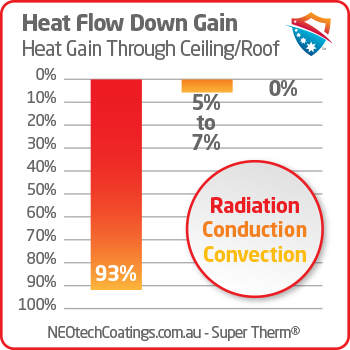
Radiation
Radiation is a method of heat transfer that does not rely upon any contact between the heat source and the heated object. For example, we feel heat from the sun even though we are not touching it. Heat can be transmitted though empty space by thermal radiation. Thermal radiation (often called infra red radiation) is a type electromagnetic radiation (or light). Radiation is a form of energy transport consisting of electromagnetic waves. No mass is exchanged and no medium is required, therefore we can lose much of our energy through ineffective ways of managing heat loss through radiation.
Super Therm® with its 367 to 4 BTU infrared block is able to reflect heat back to its source which either prevents heat penetration which is great for air conditioners or traps heat for internal heating. Both methods save money and reduce environmental impact from heat load and power consumption.
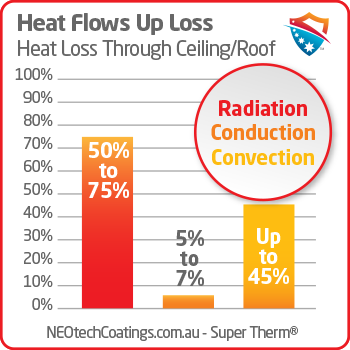
Conduction
Both conduction and convection require matter to transfer heat. Conduction occurs when two object at different temperatures are in contact with each other. Heat flows from the warmer to the cooler object until they are both at the same temperature. Therefore heat moves from the outside to the inside on a hot day…and in reverse if heating is on inside.
Conduction is the movement of heat through a substance by the collision of molecules. At the place where the two object touch, the faster-moving molecules of the warmer object collide with the slower moving molecules of the cooler object. As they collide, the faster molecules give up some of their energy to the slower molecules. The slower molecules gain more thermal energy and collide with other molecules in the cooler object. This process continues until heat energy from the warmer object spreads throughout the cooler object.
Some substances conduct heat more easily than others. Solids are better conductor than liquids and liquids are better conductor than gases. Metals are very good conductors of heat, while air is very poor conductor of heat. You experience heat transfer by conduction whenever you touch something that is hotter or colder than your skin e.g. when you wash your hands in warm or cold water.
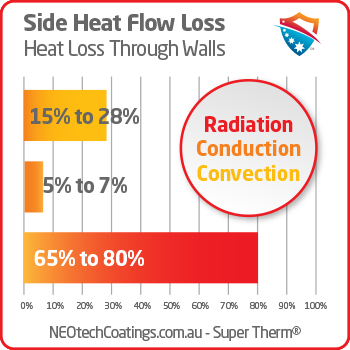
Convection
In liquids and gases, convection is usually the most efficient way to transfer heat. Convection occurs when warmer areas of a liquid or gas rise to cooler areas in the liquid or gas. As this happens, cooler liquid or gas takes the place of the warmer areas which have risen higher. This cycle results in a continuous circulation pattern and heat is transferred to cooler areas. You see convection when you boil water in a pan. The bubbles of water that rise are the hotter parts of the water rising to the cooler area of water at the top of the pan. You have probably heard the expression “Hot air rises and cool air falls to take its place” – this is a description of convection in our atmosphere. Heat energy is transferred by the circulation of the air.
California Cool Roof Program
Super Therm®, unique properties, especially its ability to keep surfaces cool even in extreme temperatures, enabled the coating to pass muster in the California “COOL ROOF” engineering research program with the highest marks.
Results from the COOL ROOF program:
- Ultraviolet radiation (UV) = 97% blocked
- Visible radiation (VIS) = 92.2% blocked
- Infrared radiation (IR) = 367 to 4 BTU blocked
Eco-Friendly Heat Block Solution
Energy Star Ratings
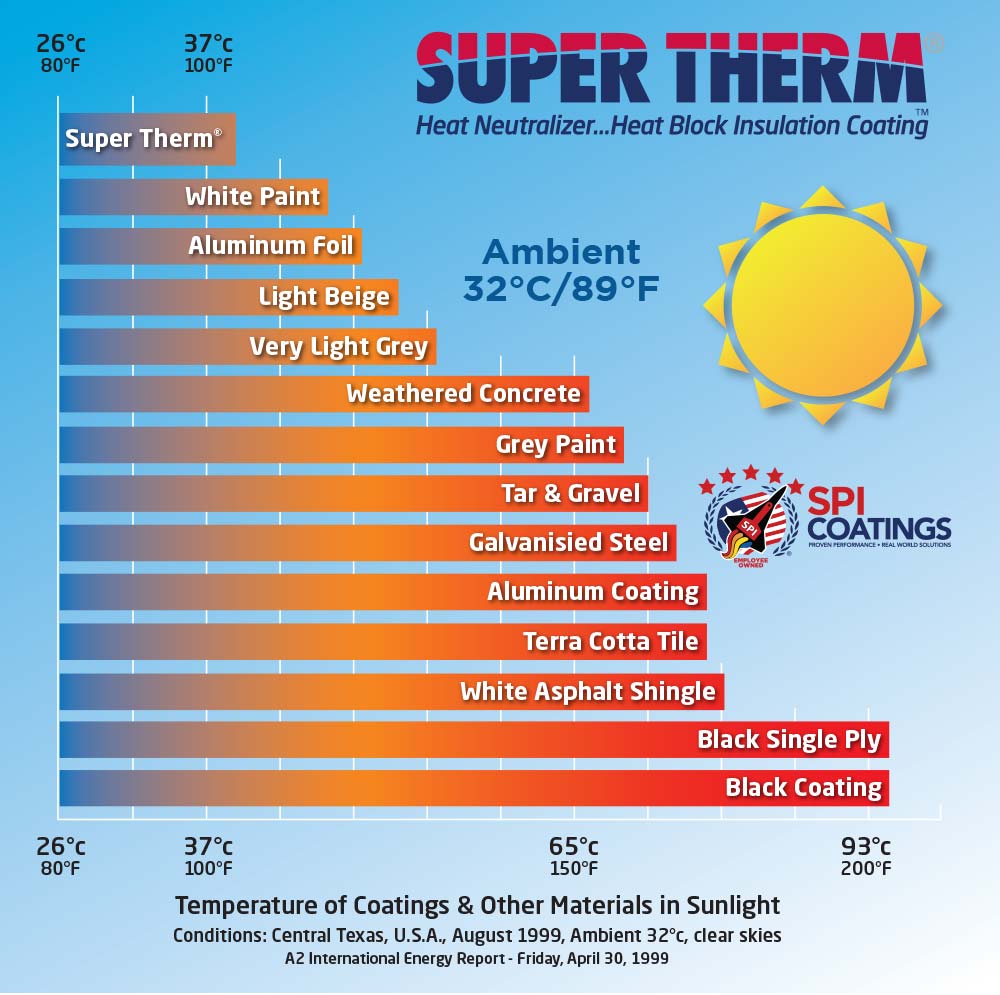
Super Therm® is Energy Star qualified as a 20 year roof coating.
In the USA, about $40 billion annually to air condition buildings – sixth of all electricity generated in the country.
- Energy Star qualified roof products reflect more of the sun’s rays. This can lower roof surface temperature by up to 37.7°c, decreasing the amount of heat transferred into a building.
- Energy Star qualified roof products can help reduce the amount of air conditioning needed in buildings, and can reduce peak cooling demand by 10-15 percent.
- Although there are inherent benefits in the use of reflective roofing, before selecting a roofing product based on expected energy savings consumers should explore the expected calculated results that can be found on the Department of Energy’s “Roof Savings Calculator” website at www.roofcalc.com.
- Please remember the Energy Savings that can be achieved with reflective roofing is highly dependent on facility design, insulation used, climatic conditions, building location, and building envelope efficiency.
Visit Energy Star website (Roofing) (USA)
Cool Roofing: LEED and Metal Roofing
Products and coatings can help buildings meet program requirements
Metal roofs have long been popular with architects for their dramatic appearance and long-term performance characteristics, particularly their low maintenance costs and durability. With the concept of sustainability now being widely embraced by the architectural community, metal roofs are being seen in a new light.
Metal roofing can contribute significantly to the sustainable building movement. Their high recycled content, total recyclability and energy efficiency allow “cool metal roofs” to qualify for points in the Energy Star and Leadership in Energy and Environmental Design (LEED) Green Building Rating System programs. More





















